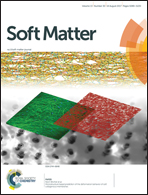Tuning Coulombic interactions to stabilize nematic and smectic ionic liquid crystal phases in mixtures of charged soft ellipsoids and spheres†
Abstract
We have investigated the effect of electrostatic interactions in mixtures of soft ellipsoids and spheres based on the well-known Gay-Berne (GB) and Lennard-Jones (LJ) potential, respectively. These model systems, in their original version, that is without any electrostatic charge, have been thoroughly investigated in the literature both as pure components and mixtures. In particular, mixtures of particles of different shapes, such as spheres and ellipsoids, tend to phase separate because of the excluded volume effects. Common ionic liquid crystals, based on imidazolium or other quaternary ammonium salts, are usually composed of roughly elongated (although flexible) cations and roughly spherical anions, that is, particles with a similar shape such as the GB and LJ models. Therefore, in this work, we present the results of molecular dynamics simulations of mixtures of positively charged GB and negatively charged LJ particles as models of ionic liquid crystals. Interestingly, by modulating the charge of the particles it is possible to stabilize isotropic, nematic, smectic and crystalline ionic phases. The relative weight of Coulomb (a radial, therefore isotropic interaction) and van der Waals (an anisotropic interaction) contributions is a key parameter to tune the stability of various mesophases.



 Please wait while we load your content...
Please wait while we load your content...